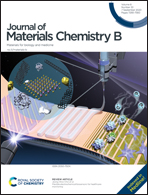Complete zwitterionic double network hydrogels with great toughness and resistance against foreign body reaction and thrombus†
Abstract
Conventional tough hydrogels offer enhanced mechanical properties for load-bearing implants; however, their application is still hindered by a lack of biocompatibility. In this study, we demonstrate a new methodology for developing biocompatible double network (DN) hydrogels by using a responsive amphoteric polymer as a first framework. Tough DN hydrogels were formed by penetrating zwitterionic poly(sulfobetaine acrylamide) (PSBAA) into a swollen poly(lysine acrylamide) (PLysAA) network in an acidic or alkaline solution, and polymerizing under UV irradiation. The DN hydrogels were able to become zwitterionic entirely under physiological conditions, and possess excellent mechanical strength, comparable to conventional DN hydrogels with permanently charged polyelectrolyte frameworks. Additionally, in vitro studies including biofouling, cytotoxicity and hemolysis were conducted to show the superior biocompatibility of the complete zwitterionic DN hydrogels. After the circulation of human blood in tubular DN hydrogels, the zwitterionic DN gels displayed negligible thrombus formation. Furthermore, PLysAA/PSBAA hydrogels were implanted subcutaneously, showing excellent resistance against inflammatory response and long-term capsule formation. This work has presented a new strategy for synthesizing a biocompatible tough DN hydrogel to effectively mitigate the foreign body reaction to render great benefit for the development of biomedical implants.



 Please wait while we load your content...
Please wait while we load your content...